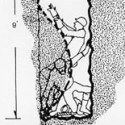|
mr.belowaverage posted:How can mounting a tv over the tub be code-compliant, if you can't even put a light switch within reach? I'd check into that. Its all gonna be about how high above the tub one could get it were it to be directly above. I learned this when I bought a hanging light fixture for my bathroom when building my house. It goes out in the middle of the room and its not like you can hit your head on it or anything but the electrician wouldnt install it because it was like..within one inch of the code rating for how many inches above the surface of the water an electrical appliance must be. Essentially you're not supposed to be able to stand up in the tub and touch anything electrical. If he's putting it several feet away and well up high he's golden but I'd still recommend a good mount, a safety chain (not cause its a bathroom but just advisable anywhere a tv is mounted very high) and a solid GFCI. One could put it above the tub if they had really high ceilings..but i guess it becomes kindof silly because of the viewing angle  Edit: another high mounted appliance safety tip that cost about 2c to do; zip tie the electrical cord for the device in a tightly wound configuration that only reaches the plug with a few inches to spare and a few inches shorter than the safety chain. This way if the device comes off of its mount the cord will remove itself from the outlet before it hits the end of the safety chain and is ever within reach of possibly touching a person. More helpful in wet locations, but really applicable anywhere you mount consumer electronics taking line voltage up high. If you have a tv smashing on your head you'd probably have a minor additional inconvenience if its got live power. chedemefedeme fucked around with this message at 05:44 on Apr 4, 2011 |
|
|
|

|
| # ? May 8, 2024 21:15 |
|
artificialj posted:There is no way I can run wires behind the walls, and no studs or whatever to fix things to, so can I just run some sort of flexible conduit and attach it to the paneling? What sort of conduit am I looking at, and what sort of outlet boxes? Wires have to "be protected against physical damage." That means some kind of conduit or at least 1 1/8" back from the wall. I'm kinda seeing wiremold in your future. It's not particularly pretty, but it is pretty easy, cheap, and code-compliant. There's a whole line of outlet boxes, etc etc etc to fit wiremold to whatever code-legal concealed wiring system you have. If you think wiremold is ugly and ghetto (it totally is) then conduit behind your furring strips is about the only legal way. I'd have to check, but unless it's type AC, I don't think you can run flexible conduit in a dwelling without the other kinds of physical damage protection.
|
|
|
|
JimbobDobalina posted:
I'm looking through all my stuff, and even Philips, who has a major hard-on for LEDs is not recommending LEDs for big floodlighting projects. They like them for wallwashing and spotlighting, but they are still HEAVILY pushing their magic electronic ballasts for HID lighting for low-cost long-term energy-saving outdoor lighting. Direct-view? LEDs. Wallwash with color-change? LEDs. Street lights? HID/metal halide. Wait a few years, still.
|
|
|
|
babyeatingpsychopath posted:Wires have to "be protected against physical damage." That means some kind of conduit or at least 1 1/8" back from the wall. I'm kinda seeing wiremold in your future. It's not particularly pretty, but it is pretty easy, cheap, and code-compliant. There's a whole line of outlet boxes, etc etc etc to fit wiremold to whatever code-legal concealed wiring system you have. Wow, yeah just looked up wiremold. Definitely hate it. So is just affixing this stuff to the wood paneling a no-go: http://www.homedepot.com/Electrical...catalogId=10053 and then running that to some metal outlet boxes on the wall? Would almost rather it be super-ghetto than ghetto-trying-to-look-not-ghetto (if that makes sense). What about running wires in EMT conduit (and why can't I find any EMT conduit on homedepots website?)? I think I have a conduit bender somewhere around here...
|
|
|
|
Both are perfectly legal. Looks lovely. But it works. Be sure to pull your wires with less then 360 degrees of bends between point to point. And ream all your emt pipes very well so you don't damage the insulation.
|
|
|
|
babyeatingpsychopath posted:I'm looking through all my stuff, and even Philips, who has a major hard-on for LEDs is not recommending LEDs for big floodlighting projects. They like them for wallwashing and spotlighting, but they are still HEAVILY pushing their magic electronic ballasts for HID lighting for low-cost long-term energy-saving outdoor lighting. Thanks for that... I'd kinda figured. I found a couple of chinese suppliers that suggest their 450W LED units were direct replacements for the 1000W bulbs we use, but I couldn't find a local distributor. Also, they didn't have any literature to back up their claims. How about induction lighting? I've been reading a bit on that, unlike LED it seems suitable for really bright lights, but the per-unit price is very high still. I'll look into the possibility replacing the ballasts and bulbs, but keeping the existing poles and mounts then.
|
|
|
|
babyeatingpsychopath posted:Wires have to "be protected against physical damage." That means some kind of conduit or at least 1 1/8" back from the wall.
|
|
|
|
There is an exception for fishing wires through areas already built and not accessible for service.
|
|
|
|
artificialj posted:What about running wires in EMT conduit (and why can't I find any EMT conduit on homedepots website?)? I think I have a conduit bender somewhere around here... Farm Supply stores and Co-ops have EMT. High wattage, Explosion-Proof LED fixtures are starting to get more common in oilfields. Just a matter of time before flood lights get their turn, but I'm not looking forward to that. I loving hate seeing LEDs that don't have a shade on them. LED headlights aggravate me so much while I drive.
|
|
|
|
artificialj posted:What about running wires in EMT conduit (and why can't I find any EMT conduit on homedepots website?)? I think I have a conduit bender somewhere around here... I found some on their site just searching for "emt"... Don't worry, Home Depot carries EMT, I've bought EMT from their stores before. If running conduit, you'll want to use individual conductors instead of NM, they will be easier to pull. That means getting cut so many feet of black, so many feet of white, so many feet of green, and so many feet of red for your 220V run.
|
|
|
|
kid sinister posted:I found some on their site just searching for "emt"... Don't worry, Home Depot carries EMT, I've bought EMT from their stores before. Cool, thanks. So is 12 gauge wire good for both the 110 and 220? Or should I be going for heavier gauge for the 220? Just in case it matters, I'm going to be running a 3hp, 3ph motor like this: http://www.baldor.com/products/deta...ting=40CMB-CONT (with a VFD for converting my house 1ph to 3ph).
|
|
|
|
artificialj posted:Cool, thanks. So is 12 gauge wire good for both the 110 and 220? Or should I be going for heavier gauge for the 220? Just in case it matters, I'm going to be running a 3hp, 3ph motor like this: http://www.baldor.com/products/deta...ting=40CMB-CONT (with a VFD for converting my house 1ph to 3ph). Base your wire gauge on amperage, not voltage. For wiring the voltage will only matter for the insulation rating; 600V rated insulation is probably the most common for branch circuits.
|
|
|
|
It gets a bit tricky with a VFD. You have to derate the VFD to 50% of the load it could supply with 3-phase power. You also end up with more amperage on your line feeding the VFD. You also need a VFD that is rated for single phase to 3-phase use. Check you manual. You will probably need a 6 hp or better VFD to do this. I'm not sure how to convert three phase to single phase but I believe you multiply the 3-phase current by 1.732. So 1.732*8.2= 14.2 amps. If you are going to be running the motor continuously (more then three hours straight)then multiply 1.25 * 14.2 = 17.753 amps. In either case a 12 gauge conductor should work. I'm not sure what sort of over-current protection you need.
|
|
|
|
tworavens posted:It gets a bit tricky with a VFD. You have to derate the VFD to 50% of the load it could supply with 3-phase power. You also end up with more amperage on your line feeding the VFD. You also need a VFD that is rated for single phase to 3-phase use. Check you manual. You will probably need a 6 hp or better VFD to do this. This is Amps per phase conductor: Single phase: VA = Volts x Amps Three phase: VA = Volts x Amps * 1.732 I'd use 220V. Buy a motor-starter VFD rated for 3hp motors and your motor voltage and you should be good. (Full load current for a 3hp motor is 4kVA, btw.) When starting motors (or when stalled), they momentarily draw locked-rotor current, which will be much higher and you need to ensure your circuit can handle that. #12 wire is too small and will not be sufficient.
|
|
|
|
Thanks guys!grover posted:#12 wire is too small and will not be sufficient. So should I be using 10 gauge? Or 8? Just to let you guys know, my application is going to be running large belt sander/grinder, so this is definitely not going to be in any sort of continuous use. I was thinking about a VFD like this: http://dealerselectric.com/item.asp?PID=737 . Although I probably should spend the extra money for a NEMA 4 rated enclosure, I was thinking about locating my VFD in a clean area, and running the whole thing remotely.
|
|
|
|
artificialj posted:Thanks guys! 12 AWG. NEC 430. (Motors) part X (Adjustable speed drives) deals with this pretty well. Minimum conductor size has to have an ampacity not less than 125% of the rated input to the power conversion equipment (VFD) (430.122(A)). The rated current of that model is 10.5A. 10.5*1.25=13.125A, fine for #12 on a 20A breaker. Overload protection is built in to the VFD, so you don't need overloads (430.124(A)). The VFD provides thermal protection as well, so that's fine (430.126(A)). This motor will need a disconnecting means. As long as your breaker is less than 50' away and within sight of your motor, you can use your breaker as the disconnecting means for the whole shebang (VFD, Motor, etc) (430.102). ALL of these calculations take in start-up surge, etc etc. So #12, 20A breaker. You're technically allowed to go with an instantaneous-trip circuit breaker up to 800% of full-load current to allow for starting current. So 9.6A * 8 = 76.8A, rounded down, 70A breaker on your #12s, provided the only thing on the circuit is the motor/VFD combo. Spring for the NEMA 4X enclosure and mount it wherever you want. 4X is good for wind, rain, water washdown, dust intrusion, etc. It's the same rating required for agricultural buildings. babyeatingpsychopath fucked around with this message at 17:35 on Apr 5, 2011 |
|
|
|
Just found out that Washington State, due to budgetary cutbacks is not going to consider implementing the 2011 NEC code until 2012 at the earliest. I'm planning a remodel though this year, and haven't read the new code yet. I am aware of the 14/3 light switch change, but as far as common residential things is there any other big change?
|
|
|
|
RedReverend posted:Just found out that Washington State, due to budgetary cutbacks is not going to consider implementing the 2011 NEC code until 2012 at the earliest. I'm planning a remodel though this year, and haven't read the new code yet. I am aware of the 14/3 light switch change, but as far as common residential things is there any other big change? No more multiwire branch circuits unless the breakers are tied together, neutral going to switches, AFCI on most places, GFCI on the rest.
|
|
|
|
babyeatingpsychopath posted:No more multiwire branch circuits unless the breakers are tied together, neutral going to switches, AFCI on most places, GFCI on the rest. I thought AFCIs were 2008? I know tamper-resistant receptacles indoors and weather-resistant receptacles outdoors were 2008...
|
|
|
|
The AFCI thing hasn't made it to Washington yet. I heard something about GFCI's in all roof and attic spaces, and everywhere in the garage.
|
|
|
|
kid sinister posted:I thought AFCIs were 2008? I know tamper-resistant receptacles indoors and weather-resistant receptacles outdoors were 2008... GFCI, as a general rule, are required everywhere there's water: kitchen, bathroom, garage, exterior, basement.
|
|
|
|
grover posted:AFCIs used to be just for bedrooms, but 2011 code is that they're required pretty much everywhere that isn't already required to have a GFCI. How is that supposed to work in practice? My electrical panel isn't some ancient relic, but nobody makes AFCI breakers for it. Even if I had a brand new Square D panel the cost difference is ridiculous. For a 15A breaker, Home Depot wants over $80 for AFCI or $10 for standard. Like hell I'm going to pay an extra $70 to put in a one outlet branch circuit to power my central vac. What happens if somebody needs to replace a broken receptacle? Would they be required to make that AFCI (which could mean a new breaker, which means new panel, which means the whole house brought up to 2011 code, etc. etc.) While I was looking into it I came across this video which suggests that it's being pushed back until 2014 to allow AFCI receptacles to come on the market, is that correct? http://www.youtube.com/user/MikeHoltNEC#p/u/16/IHZ1FsR2dh4 Sorry if I sound a bit harsh, that's not my intention, I just have a lot of questions about how these changes will affect modifications to slightly older existing homes.
|
|
|
|
grover posted:GFCI, as a general rule, are required ... basement. Arg, how long has that been the case? In 2006, I just put GFCI in my walkout basement bathroom circuit, on the wet bar circuit, on the sump pump, and on the circuit going outside. The rest of my basement circuits are not GFCI and, even worse, the lighting circuits don't have receptacles on them, so I'd have to do it on the breaker. Hopefully GFCI twin breakers exist.
|
|
|
|
SolidElectronics posted:How is that supposed to work in practice? My electrical panel isn't some ancient relic, but nobody makes AFCI breakers for it. Even if I had a brand new Square D panel the cost difference is ridiculous. For a 15A breaker, Home Depot wants over $80 for AFCI or $10 for standard. Like hell I'm going to pay an extra $70 to put in a one outlet branch circuit to power my central vac. Which is why I'm going to get as much done this year before Washington State adopts the 2011. AFCIs are ridiculously expensive. As for a broken receptacle, you can go ahead and replace it without having to update your panel. Your system will be grandfathered in and you will be okay unless you add something new or do any other work to your panel.
|
|
|
|
jackyl posted:Arg, how long has that been the case? In 2006, I just put GFCI in my walkout basement bathroom circuit, on the wet bar circuit, on the sump pump, and on the circuit going outside. The rest of my basement circuits are not GFCI and, even worse, the lighting circuits don't have receptacles on them, so I'd have to do it on the breaker. Hopefully GFCI twin breakers exist. It's doubtful you'll find twin GFCIs, the GFCI circuitry makes a GFCI breaker even larger than a regular breaker. Anyway, the code is that only receptacles, not lights, in unfinished basements need to be GFCI protected. It's been that way since 2005 I think. There are some exceptions, like dedicated receptacles for certain appliances on their own circuits.
|
|
|
|
kid sinister posted:Anyway, the code is that only receptacles, not lights, in unfinished basements need to be GFCI protected. That's good, I was wondering how I missed that requirement. It wouldn't have been hard to protect all my receptacle runs, although it would have been irritating, but the lights would have really sucked.
|
|
|
|
Maybe I should clarify a bit more... Receptacles in unfinished parts of basements need to be GFCI protected, like storage areas, utility rooms, etc. Receptacles in finished parts of basements need GFCIs only for the usual GFCI restrictions: kitchens, bathrooms and garages.
|
|
|
|
I have an outdoor cement block building (shed) that is currently wired (and has been inspected, it's currently up to code, and has it's own breaker). I'm finishing the interior, and currently putting up a 2x2 framework. I've decided it's going to be easier to pull out the existing wiring, and put in romex and new outlets. The wiring is currently in conduit piping around the room. If I'm putting rigid foam insulation between the studs, and then covering with drywall, what do I have to do to be up to code? My loose plan right now is to put the romex behind the insulation, but I don't know if I should drill through the small studs, or knock a v shaped gap out of the back of the studs...I'm already probably showing my ignorance here. Basically, I want about 6-8 outlets in a 12x12 structure that is dry, and want to do it inside of a very thin wallspace. Help and advice are appreciated.
|
|
|
|
I didn't realize this thread existed, so I asked in totally the wrong place. Crosspost! Say I've got a lovely townhouse-style garage. It's got a 15 amp breaker on it, which I believe may also be shared between some parts of the kitchen. Probably just the lights, if anything. Now say that sometimes--not often, but sometimes--when I turn on my tablesaw, I trip the breaker. Would it be a Very Bad Idea™ to just swap in a 20 amp breaker on it? I don't believe the circuit would ever need to sustain 20 amps, just while my saw spins up and draws more current for all of a second. I realize that running 20 amps continuously could be a problem if the wiring isn't heavy enough, but I can't imagine the difference would be that critical, especially if the bigger draw was only temporary.
|
|
|
|
|
It depends. The way some electricians interpret the code they think they need to put 15A breakers on all circuits with normal receptacles. This isn't true. So if you have 12 gauge wire, and you can be absolutely certain that you have it all through that circuit then you can put a 20A breaker in. I definitely wouldn't if it was 14 gauge. I also wouldn't if it was knob and tube wiring. If that isn't an option you can do this: http://www.harborfreight.com/router-speed-control-43060.html Its a speed controller for 15 amp and under ac/dc motors. Basically your motor is tripping the breaker because when you start a motor its drawing more then 15 amps. This will limit that initially and after its running you can turn up the speed full blast.
|
|
|
|
Knob and tube? e: Nevermind, googled it. Definitely not that, the place is roughly ten years old. Of course, that only speaks to the building techniques rather than the building quality, as it's one of those built-by-the-dozens, hey-let's-make-more-suburbia-lol type places. It looks like most of the wiring coming out of the breaker box is 12? But it's drat hard to read (since it's just embossed on the outer sheath instead of actually printed) and I have no idea which line is actually which. Bad Munki fucked around with this message at 01:14 on Apr 12, 2011 |
|
|
|
|
tworavens posted:If that isn't an option you can do this: This is an excellent, very cheap and safe option for this situation. This is a solution that doesn't require a continual safety risk to solve an occasional issue. If you're only tripping at startup this will most positively eliminate that. Could just set it at 90% all the time and forget its there without likely noticing the effect on your cutting unless you're working right at the edge of your saw's capability.
|
|
|
Hmm. That's probably do-able, then. Hell, maybe it'd be nice to have a speed control on there anyhow. Maybe I wouldn't find myself burning nice maple as often.  Thanks!
|
|
|
|
|
Tablesaws generally use a synchronous motor, so you probably couldn't control the speed with that device.
|
|
|
|
Oh, well, whatever. I don't even know what that means. If it's of interest, I can take a picture of the wiring diagram plate on the back of the motor.
|
|
|
|
|
That'd probably tell us enough to know if it is compatible, perhaps also a motor part number.
|
|
|
|
Can do! This is a very old Rockwell motor, circa 1960-something. Here's a full-frontal that shows all the wiring info:  And here's a sexy-sexy upskirt shot that shows the model number and such:  And one last one that shows the info at the bottom of the panel:  Upon closer inspection, it looks to be actually rated at 20 amps, but that must be the stall load or something because like I said, only rarely do I ever trip the 15 amp breaker this thing is running on. I've done it a few times while powering up the saw, and only once or twice while actually cutting, and that was like 8/4 hardwood. I think when it does happen, it's cause all the kitchen lights are on at the same time. So yeah, 20 amp stall, maybe?
|
|
|
|
|
Bad Munki posted:Can do! This is a very old Rockwell motor, circa 1960-something.
|
|
|
|
Bad Munki posted:... all the kitchen lights are on at the same time ... If you're running incandescent/halogen bulbs in the kitchen this can be placing a lot of strain on this circuit when combined with a 20a motor starting up. Save yourself some $$ and switch to LEDs (or at least CFLs). If you're already running LEDs or CFLs in your kitchen and dont have 15 of them on at once the load is likely negligible. If you're running 4, 6 or even 8 100w incandescent flood bulbs this very well could be a significant contributor. Seems obvious these days but I'm surprised the number of people I've spoken with who use 6 or 8 100w floods in their kitchen recessed fixtures for hours and hours a day and don't realize the potential savings (and reduced risk of overheat/fire).
|
|
|
|

|
| # ? May 8, 2024 21:15 |
|
If I plan on soldering a decent amount of wires, would it be a good investment to pick up a respirator?
|
|
|



















